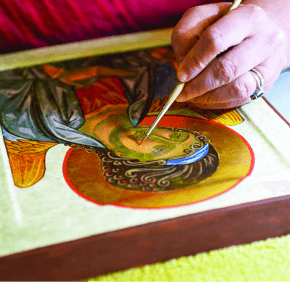By Mary K. Tilghman
Special to the Review
Whether the artist is a newbie or experienced doesn’t matter. Each creates an icon, a religious painting filled with symbolism and the artist’s own prayer and reflection.
Some 20 iconographers attended an April workshop led by internationally known icon masters at the Shrine of St. Anthony, a repurposed Franciscan monastery in Howard County.
“It’s a wonderful, spiritual practice,” said Laura Clerici, a retired diplomat who created her first icon in Moscow in 2000. “You’re doing something but you’re meditating at the same time. You’re connecting to the Holy Spirit. Once you figure that out you can’t stop.”
Each day began with chanted prayer for their day’s work. Andrejev then spoke, delving into various aspects of this religious art form, followed with demonstrations on technique throughout the day.
The talk April 21 considered God’s presence in both light and dark.
Most understand the concept of light as a metaphor for God, according to Andrejev.
“It is important to portray the light of God. It’s invisible. It’s transcendent,” he said, but there is a divine darkness, “the mystery of God.”
The creation of an icon takes 22 steps, from the blank wooden board to each layer of paint, clay and gold leaf, to the oil that seals the finished icon.
Vladislav Andrejev, founder of the Proposon School of Iconography, shares a thought with Kristin Catena who was attending her third workshop at the Shrine of St. Anthony in Ellicott City. (Kevin J. Parks/CR Staff)
“The true icon,” he added during the lunch break, “is within our souls.”
“Every medium you use, every color you use, everything has a symbol of spirit and life,” said Judy Kersse, a parishioner of Our Lady of Perpetual Help in Ellicott City. “It really is a spiritual journey. You’re writing an icon on your heart.”
Each painter applies layers of egg tempera, a traditional mixture of egg yolk, wine and colored powders, with delicate brushes. Some also employ tablets and smartphones to enlarge portions of the images they are working on.
To the uninitiated eye, it looked as if each artist was merely copying an old icon, but Lynette Hull, of Princeton, N.J., an experienced iconographer, likened the experience to a musician interpreting a score.
“We each bring our own personalities, our strengths and weaknesses to the icon,” she said.
Kristin Catena of Rising Sun agreed.
“There are quite striking differences even though it’s the same icon,” she said. “I think that’s a beautiful reflection of each individual.”
Marianist Brother Gary Marcinowski, a professor of sculpture at the University of Dayton, designed the altar, presider’s chair, ambo and tabernacle at St. Joseph’s Church in Sykesville in 1998. While well versed in other forms of liturgical art, this was his first iconography workshop.
“They are transitions, windows into spirituality,” he said.
“You’re writing a prayer,” said Mick Michieli-Beasley, a member of St. Lawrence Parish in Jessup and the Archangel Michael Icon Guild. “All those beautiful prayers go up and God hears them.”
Ray Bullock, a parishioner of St. Joseph-on-Carrollton Manor in Buckeystown, kept his first icon of Jesus’ face simple, focusing especially on the eyes and the mouth.
“Everything,” he said, “happens there.”
Icons he painted 10 years ago sustained him after his first wife’s death.
“When I lost my wife, I was in front of the icons every day and they helped me,” he said.
Debbie Baronas, another OLPH parishioner, was touched by the symbolism of each step. The golden halo around her image of the angel Gabriel was created by covering the surface with clay and layering on 24-karat gold.
“You’re making a prayer to the Holy Spirit to work through you,” said Josephine Richards of Carlisle, Pa. “It’s praying in color.”
Also see:
Beauty beneath the grime: Basilica’s Stations of the Cross undergo restoration
U.S. architect recalls events that led him to design chapel at Vatican


